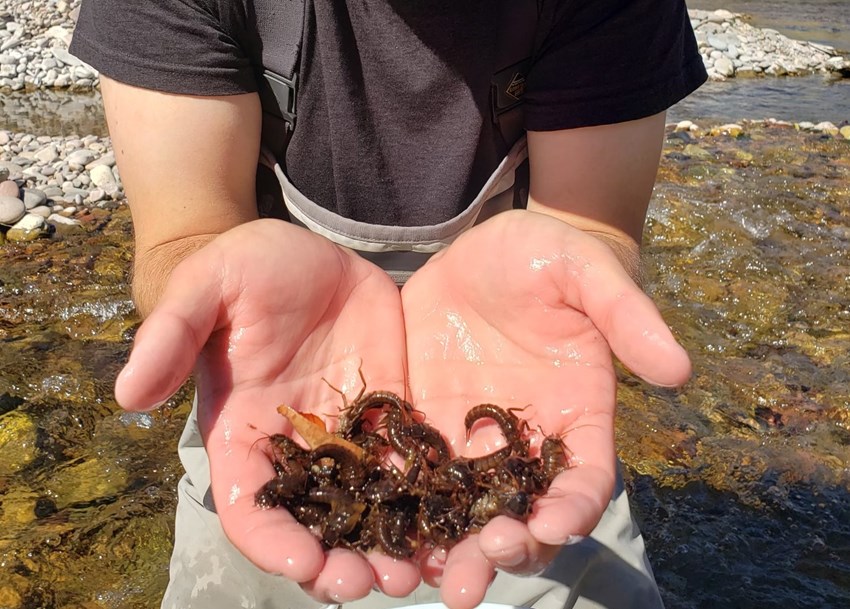UM Bio Station Study Indicates Salmonflies May Have Ability to Adapt to Warming Mountain Streams
With each passing year, climate change is altering characteristics and increasing the temperatures of mountain streams all over the world. These changing conditions are impacting mountain-dwelling organisms in a number of direct and indirect ways, and the fate of many of these organisms will be determined by their ability to adapt and evolve before they become extinct.
To this point, determining which populations will persist in any particular location has been no easy task. But thanks to a study recently published in the Journal of Experimental Biology, University of Montana (UM) Flathead Lake Biological Station assistant research professor Rachel Malison and a team of UM researchers are closer to understanding how one particular organism, the salmonfly (the largest stonefly in Montana), may be reacting to the rising freshwater temperatures of our changing world.
Like all organisms, populations of aquatic insects may respond to climate change in a number of ways. These responses include shifting their range, evolving new physiologies and behaviors, exhibiting physiological and behavioral plasticity, or going extinct.
“We studied salmonflies because they are an important part of the food web, one salmonfly can provide a lot of energy to a fish, and they have a lot of gills (where oxygen is taken up) which was important for physiology measurements,” said Malison. “We need to understand how aquatic insect populations will respond to changing habitats because they play critical roles processing materials in streams and providing food for other organisms.”
Focusing on physiological and behavioral plasticity responses, Malison and her team measured changes in growth, survival, and observable respiratory traits of salmonfly nymphs in different experimental combinations of dissolved oxygen and temperature. The specific combinations were used because rising temperatures can stimulate a higher metabolic demand for oxygen in organisms that exceeds available oxygen in the surrounding environment, which results in insufficient oxygen for the organism
After introducing salmonfly nymphs to varying temperature and dissolved oxygen conditions over a six-week experimental period, the scientists found that oxygen and temperature interacted to affect growth in complex ways. They also found that the survival rate was only slightly lower for the nymphs subjected to warmer water temperatures. Nymphs that were able to acclimate to the warmer temperatures did not show any changes to their mobility in relation to temperature, but the nymphs that acclimated to lower oxygenated water did start to lose mobility and coordination at warmer temperatures than normal.
“The temperature at which organisms lose their ability to move normally is an important indicator of temperature tolerance,” Malison said. “If a stonefly can’t crawl or flip themselves over, they can’t escape predators.”
The study’s results suggest that the salmonfly nymphs may have enough adaptive plasticity of their internal systems that uptake or deliver oxygen to survive at least some of the changing conditions of their mountain stream habitats.
To further test the initial findings of the study, Malison and her team observed and measured the oxygen sensitivity of metabolic rates and gills structures located on the thoracic segments of the salmonfly nymphs. Combining the results from multiple performance metrics, their findings indicated that rising temperatures and low oxygen may interact in ways that increase health risks to aquatic insects, but that physiological plasticity in respiratory systems may be able to offset some of these risks.
To put it more simply, the results of the study suggest that acclimation may allow salmonflies to persist in warmer streams longer than previously expected.
These results are notable as scientists continue to search for answers in an uncertain future. Understanding and predicting how natural populations will respond to our changing climate is a pressing issue, and physiological plasticity may be a key mechanism of population resilience. However, assessing its potential is difficult because it can occur across many different traits simultaneously at different levels of biological organization.
“Models are often used to predict what will happen to our mountain streams and the organisms in them for coming decades, but the models are only as good as the information we put in them,” said Malison. “Having data on physiological responses at the level of the individual can greatly improve models, especially when we measure unexpected responses.”
Researchers emphasize that additional studies on more species over longer time scales are needed to provide even more ecologically relevant information on the degree to which acclimation will allow persistence in the face of climate change.
These studies may require more time and resources, but they may also reveal vital information about the long-term effects of climate change both locally and throughout the world.
Additional authors on this study include UM scientists James Frakes, Amanda Andreas, Priya Keller, Emily Hamant, Alisha Shah, and Arthur Woods. For the complete study, visit the Journal of Experimental Biology website at https://journals.biologists.com/jeb/article-abstract/225/18/jeb244253/276660/Plasticity-of-salmonfly-Pteronarcys-californica/


